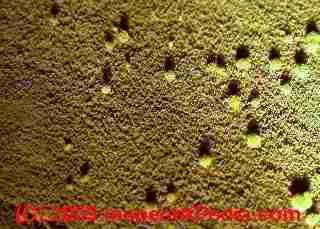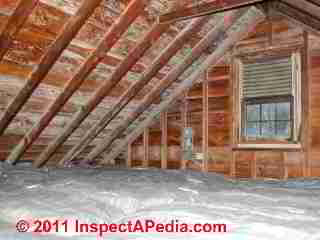 The Most Common Indoor Molds Found in Buildings
The Most Common Indoor Molds Found in Buildings
- POST a QUESTION or COMMENT about the most common mold contamination types found in buildings and on building surfaces
Frequency of occurrence of indoor molds by genera/species:
Here is a mold frequency table guide to the most common building molds found in mold test samples collected in buildings, based on surface tape samples submitted to an expert mycologist in New York State, with additional explanation and interpretation by Daniel Friedman, an expert mold/IAQ/building diagnostic field investigator also versed in aerobiology and mold lab microscopy and mold identification procedures.
InspectAPedia tolerates no conflicts of interest. We have no relationship with advertisers, products, or services discussed at this website.
- Daniel Friedman, Publisher/Editor/Author - See WHO ARE WE?
Table of Most Common Indoor Molds Reported by Mold Test Kits
 Simple "mold screening methods" which omit the inspection, and "test only" sampling methods, such as air and culture methods
can produce very unreliable results when used quantitatively - as we discuss at IAQ Methods and at other articles at this website. See MOLD GROWTH on SURFACES for an index of what mold genera/species are frequently found on various building surfaces and materials during expert building mold inspections.
Simple "mold screening methods" which omit the inspection, and "test only" sampling methods, such as air and culture methods
can produce very unreliable results when used quantitatively - as we discuss at IAQ Methods and at other articles at this website. See MOLD GROWTH on SURFACES for an index of what mold genera/species are frequently found on various building surfaces and materials during expert building mold inspections.
Readers should be sure to see the notes following the table since the data in this table is skewed by variations in the ability of the original sample collectors to find and recognize important mold contamination in buildings. Careful visual inspection combined with physical sampling of visible mold or other key building surfaces remain the key ingredients in a reliable indoor mold investigation.
Easy-to-see molds are over-reported and hard-to-see molds are under-reported in consumer-generated mold tests and samples. This reporting error also confounds attempts to correlate mold related illness and sick building complaints with specific genera or species of indoor mold. Therefore our mold frequency table shown just below reflects what people, including largely amateurs, see and sample in buildings, and it under-reports hard-to-see light colored molds such as many of the Penicillium or Aspergillus species.
| Table of Frequency of Occurrence of Indoor Building Molds2 | |||
| Mold | Percent of Samples | Mold | Percent of Samples |
| Cladosporium sp. | 16.67 | Ceratocystis sp. | 0.49 |
| Cladosporium sphaerospermum. | 16.57 | Aureobasidium pullulans | 0.49 |
| Stachybotrys chartarum | 16.37 | Peziza cerea | 0.49 |
| Aspergillus sp. | 06.02 | Aspergillus versicolor | 0.39 |
| Penicillium sp. | 03.85 | Unid. wood rot fungus | 0.39 |
| Unidentified mold | 03.85 | Mucor sp. | 0.39 |
| Ulocladium sp. | 03.06 | Cladosporium herbarum | 0.39 |
| Cladosporium cladosporioides | 02.47 | Chaetomium murorum | 0.30 |
| Non-sporulating fungi | 02.47 | Acrodictys sp. | 0.30 |
| Chaetomium globosum | 02.37 | Aspergillus niger | 0.30 |
| Alternaria sp. | 02.17 | Papalomyces | 0.30 |
| Chaetomium sp. | 01.97 | Cunninghamella blakesleana | 0.20 |
| Ulocladium sp. | 01.97 | Paecilomyces varioti | 0.20 |
| Alternaria alternata | 01.97 | Oidiodendron sp. | 0.20 |
| Penicillium/Aspergillus sp. | 01.28 | Memnoniella echinata | 0.20 |
| Acremonium sp. | 0.99 | Microascus triganosporus | 0.20 |
| Chrysosporium sp. | 0.89 | Dendriphiella sp. | 0.20 |
| Dicyma olivacea | 0.79 | Cladosporium oxysporium | 0.20 |
| Gliomastix murorum | 0.69 | Ulocladium botrytis | 0.20 |
| Meruliporia incrassata | 0.69 | Verticllium sp. | 0.20 |
| Gliomastix sp. | 0.59 | Trichoderma harzianum | 0.20 |
| Phoma sp. | 0.49 | Chaetomium piluliferum | 0.20 |
| Ascotricha chartarum | 0.20 | Bispora betulina | 0.20 |
| MILDEW in buildings ? | 0.00 | ||
Notes to Table
1. J. Haines, New York State Museum, multi-year survey of surface samples collected on adhesive tape and submitted to NY DOS by home owners or by health department officials. Personal communication to DJ Friedman. Arranged by percent of total samples analyzed. The contents of this web page are the opinion of the author and are subject to update pending further technical and professional review.
2. Warning: because most of the samples submitted to Dr. Haines were collected by people who were not expert at recognizing or even finding the most-problematic molds in buildings, there may be an over-reporting of the dark, easy-to-see molds such as the top three in this list, and an under-reporting of the often light, hard-to-see problematic molds such as Aspergillus. sp. and Penicillium sp.. In my own field work responding to client-detected mold concerns, in most cases where the occupant or owner has seen a "scary black mold" or a "toxic black mold" a more careful study of the building discloses that it is the previously un-detected Aspergillus. sp. and Penicillium sp. which were the mobile, airborne, and dominant problematic molds to which the occupants were actually exposed.
In addition, we have been using special methods to test fiberglass building insulation for Penicillium/Aspergillus sp. in areas where the insulation has been wet or where insulation has been exposed to active mold growth such as over a wet crawl space or a moldy basement. I have often found large reservoirs of these problem molds in building insulation, observing that the reservoir is releasing high levels of airborne mold spores. This mold contamination is discoverable by contextual inspection and special test methods, but it is not at all visible to the naked eye.
An exception to the speculation that these small, hard-to-see molds are the more serious problem in buildings is during amateur cleanup and demolition work without adequate containment measures. Demolition can cause molds which are not normally airborne, such as Stachybotrys chartarum to become widely dispersed in a building.
3. Some of the molds listed in this table, even though found indoors, are unlikely to be indicative of a growing mold reservoir of that genera/species. For example, I often find Cladosporium herbarum and certain Basidiomycetes such as Ganoderma sp./G. applanatum/G. tsuge in indoor air samples but I have not found these genera/species growing on building materials. Rather they enter in outdoor air.
4. For identification photographs of mold in buildings see MOLD ATLAS & PARTICLES INDEX; for photographs of mold under the microscope see MOLD by MICROSCOPE.
In conclusion, this interesting table needs additional research with data provided by expert building investigators rather than self-collected data by individuals who spot first and sample first dark molds on building surfaces. Readers should see How to Look For Mold.
...
Continue reading at MOLD GROWTH on SURFACES, PHOTOS or select a topic from the closely-related articles below, or see the complete ARTICLE INDEX.
Or see these
Recommended Articles
Suggested citation for this web page
MOLD FREQUENCY in BUILDINGS at InspectApedia.com - online encyclopedia of building & environmental inspection, testing, diagnosis, repair, & problem prevention advice.
Or see this
INDEX to RELATED ARTICLES: ARTICLE INDEX to MOLD CONTAMINATION & REMEDIATION
Or use the SEARCH BOX found below to Ask a Question or Search InspectApedia
Ask a Question or Search InspectApedia
Try the search box just below, or if you prefer, post a question or comment in the Comments box below and we will respond promptly.
Search the InspectApedia website
Note: appearance of your Comment below may be delayed: if your comment contains an image, photograph, web link, or text that looks to the software as if it might be a web link, your posting will appear after it has been approved by a moderator. Apologies for the delay.
Only one image can be added per comment but you can post as many comments, and therefore images, as you like.
You will not receive a notification when a response to your question has been posted.
Please bookmark this page to make it easy for you to check back for our response.
IF above you see "Comment Form is loading comments..." then COMMENT BOX - countable.ca / bawkbox.com IS NOT WORKING.
In any case you are welcome to send an email directly to us at InspectApedia.com at editor@inspectApedia.com
We'll reply to you directly. Please help us help you by noting, in your email, the URL of the InspectApedia page where you wanted to comment.
Citations & References
In addition to any citations in the article above, a full list is available on request.
- ENVIRONMENTAL HEALTH & INVESTIGATION BIBLIOGRAPHY - our technical library on indoor air quality inspection, testing, laboratory procedures, forensic microscopy, etc.
- Adkins and Adkins Dictionary of Roman Religion discusses Robigus, the Roman god of crop protection and the legendary progenitor of wheat rust fungus.
- Kansas State University, department of plant pathology, extension plant pathology web page on wheat rust fungus: see http://www.oznet.ksu.edu/path-ext/factSheets/Wheat/Wheat%20Leaf%20Rust.asp
- A BRIEF GUIDE to MOLD, MOISTURE, and YOUR HOME, [PDF] U.S. Environmental Protection Agency US EPA - includes basic advice for building owners, occupants, and mold cleanup operations. See http://www.epa.gov/mold/moldguide.htm
- US EPA - MOLD REMEDIATION in SCHOOLS & COMMERCIAL BUILDINGS - - US EPA
- US EPA - UNA BREVA GUIA a MOHO / HONGO - en Espanol
- A BRIEF GUIDE to MOLD, MOISTURE, and YOUR HOME, [PDF] U.S. Environmental Protection Agency US EPA - includes basic advice for building owners, occupants, and mold cleanup operations. See http://www.epa.gov/mold/moldguide.htm
- "Disease Prevention Program for Certain Vegetable Crops," David B. Langston, Jr., Extension Plant Pathologist - Vegetables, University of Georgia (PDF document) original source: www.reeis.usda.gov/web/crisprojectpages/209797.html
- Disease Prevention in Home Vegetable Gardens [PDF], Patricia Donald,Department of Plant Microbiology and Pathology,
Lewis Jett
Department of Horticulture, University of Missouri Extension - extension.missouri.edu/publications/DisplayPub.aspx?P=G6202 - "Management of Powdery Mildew, Leveillula taurica, in Greenhouse Peppers," Ministry of Agriculture and Lands, British Columbia - Original source: www.agf.gov.bc.ca/cropprot/peppermildew.htm
- Fifth Kingdom, Bryce Kendrick, ISBN13: 9781585100224, - we recommend the CD-ROM version of this book. This 3rd/edition is a compact but comprehensive encyclopedia of all things mycological. Every aspect of the fungi, from aflatoxin to zppspores, with an accessible blend of verve and wit. The 24 chapters are filled with up-to-date information of classification, yeast, lichens, spore dispersal, allergies, ecology, genetics, plant pathology, predatory fungi, biological control, mutualistic symbioses with animals and plants, fungi as food, food spoilage and mycotoxins.
- Fungi, Identifying Filamentous, A Clinical Laboratory Handbook, Guy St-
- US EPA: Mold Remediation in Schools and Commercial Building [Copy on file at /sickhouse/EPA_Mold_Remediation_in_Schools.pdf ] - US EPA
- Mycology, Fundamentals of Diagnostic, Fran Fisher, Norma B. Cook, W.B. Saunders Co. 1998, ISBN 0-7216-5006-6
- In addition to citations & references found in this article, see the research citations given at the end of the related articles found at our suggested
CONTINUE READING or RECOMMENDED ARTICLES.
- Carson, Dunlop & Associates Ltd., 120 Carlton Street Suite 407, Toronto ON M5A 4K2. Tel: (416) 964-9415 1-800-268-7070 Email: info@carsondunlop.com. Alan Carson is a past president of ASHI, the American Society of Home Inspectors.
Thanks to Alan Carson and Bob Dunlop, for permission for InspectAPedia to use text excerpts from The HOME REFERENCE BOOK - the Encyclopedia of Homes and to use illustrations from The ILLUSTRATED HOME .
Carson Dunlop Associates provides extensive home inspection education and report writing material. In gratitude we provide links to tsome Carson Dunlop Associates products and services.

